nervous system, endocrine system and immune system
1/102
Earn XP
Description and Tags
Name | Mastery | Learn | Test | Matching | Spaced |
|---|
No study sessions yet.
103 Terms
speciation
sometimes when two populations don’t interbreed over a long period of time, they can diverge, developing recognizable physical differences. differences in base sequence will accumulate
karyotype
the characteristic types of chromosome in a species
genome
all of the genetic information of one organism/group of organisms. genomes are made of genes, a length of DNA carrying hundreds of bases (the part of DNA that stores information). typically, members of a species have the same genes, in the same sequence, diversity in the genomes is largely due to variation in individual genes.
alleles
alternative forms of a gene within a species due to a different base sequence
base pairs
two complementary DNA nucleotide bases that pair together to form a “rung of the DNA ladder”. how genome size is measured .
11 organ systems of humans
circulatory, digestive, endocrine, gas exchange, integumentary, lymphatic, muscular, nervous, reproductive, skeletal and urinary
2 main systems of communication
endocrine system and nervous system
endocrine system
is composed of glands that secrete hormones such as insulin and estrogen. hormones are chemicals that coordinate different functions in the body
nervous system
faster, but more temporary response. they use neurons, which help transmit information via nerve impulses. abt 85 billion neurons in the human nervous system. neurotransmitters (ex. dopamine) are chemicals that transmit information across synapses, which are junctions between neurons
central nervous system
takes in and process information and sends out motor response. two major parts are the brain and spinal cord. changes in the environment can trigger the CNS to work. sensory receptors (detect information) → nerve impulses → brain processes → send signals through neurons to incite a response
brain
coordinates all organs. receives and processes information, sends information to all parts of the body, stores information. information comes from sensory receptors in the main sense organs in the head. can store information for the short term or the long term
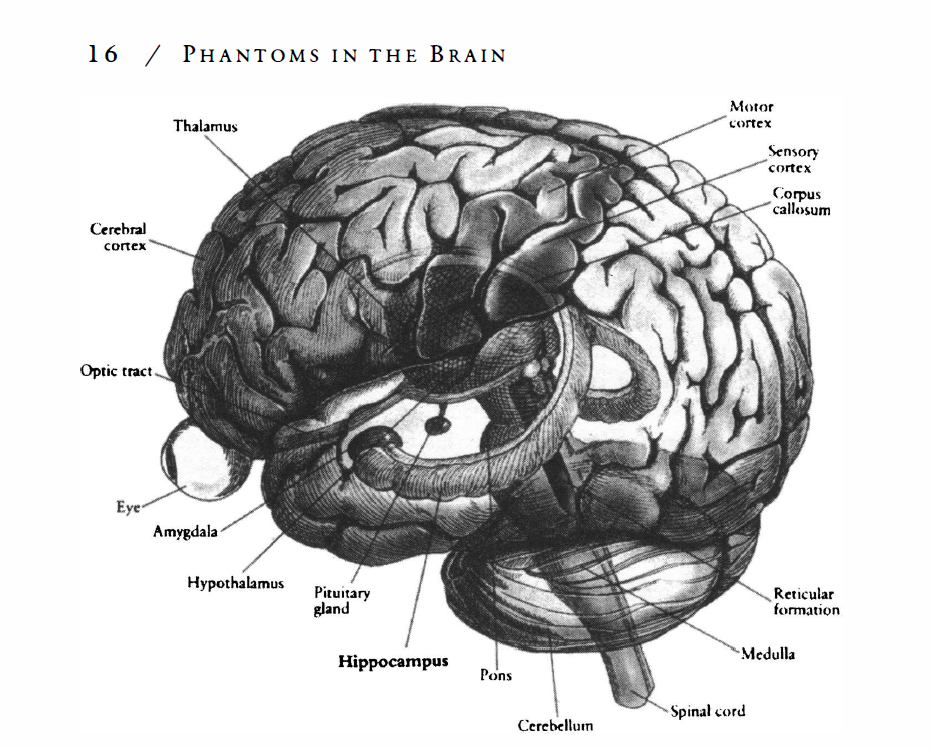
spinal cord
located inside the backbone, relays signals to and from the body. controls body movement, functions and some reflexes. reports senses to brain, which it receives form skin and muscles. is made up of white and grey matter. widest at its junction to the brain and tapers towards the pelvis. pairs of spinal nerves branch off. in humans there are 31 pairs of spinal nerves
white matter
brings signals to and from sensory receptors. contains myelinated axons and other nerve fiber.
grey matter
part that receives and regulates the information from white matter. contains cell bodies of motor neurons and interneurons. synapses here are used for processing information and decision making.
hormonal and nervous signalling
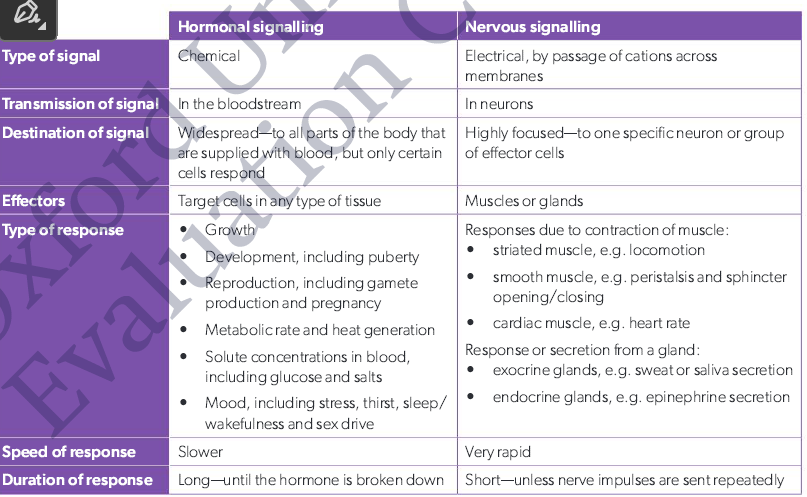
nerves
main signal carrying unit in the body. made up of a bundle of nerve fibers. located throughout the body, mostly in the skin. contains sensory neurons and motor neurons
neurons
cells within the nervous system that carry electrical impulses. they have a cell body with a cytoplasm and a nucleus, along with axons that nerve impulses travel along, ending in dendrites
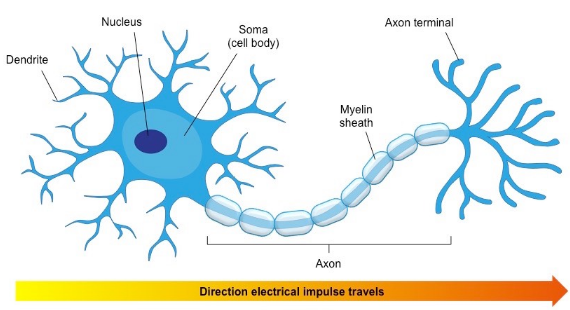
sensory neurons
in spinal cord or along nerves sense information from receptors and pass it to CNS. have long axons with synapses ending in the grey matter of the spinal cord or the brain
motor neurons
receive signals from interneurons. in spinal cord and brain determine whether or not a movement occurs
optic nerve
has only sensory neurons to send visual messages to brain
oculomotor nerve
helps with movement of the eye
receptors
sense changes in conditions. the nerve endings of them perceive a stimulus directly. they detect heat and pain
interneurons
inside CNS, have lots of dendrites. decide where to send signal for the appropriate response
effectors
carry out instructions sent by motor neurons (muscle contracting, gland secreting)
reflexes
an involuntary action performed in response to a stimulus. some are coordinated by spinal cord, some by brain
reflex arc
sequence of cells that participate in the coordination of a reflex
main parts of the brain
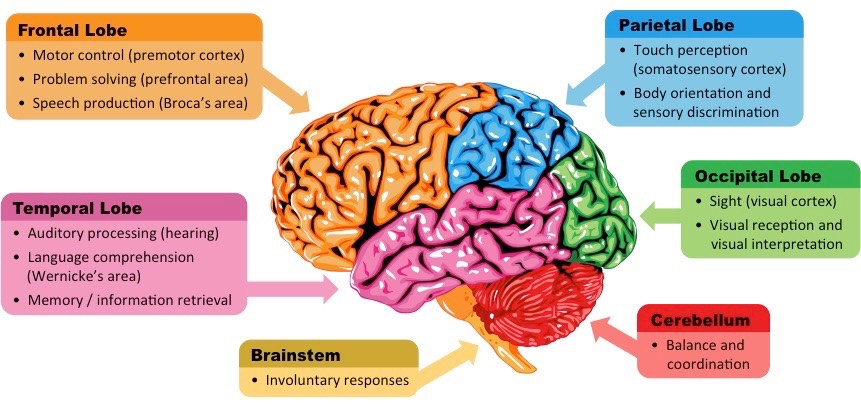
Frontal lobe
controls decision making, speech and motor control
Temporal lobe
auditory processing, memory and language comprehension
Parietal lobe
touch and body orientation
Occipital lobe
sight and visual interpretation
Cerebellum
Below cerebral hemispheres.
Controls skeletal muscle contraction and balance.
Fine-tunes the timing of contractions
Allows precise coordination of movement
Helps us maintain posture
Helps with activities requiring motor memory
Cerebrum
Consists of the two cerebral hemispheres
Control of striated muscles and certain glands
Primary motor cortex sends signals via motor neurons to each striated muscle in the body
Cell body and dendrites of many motor neurons are located in the grey matter of the cerebral hemispheres
Brainstem
posterior part of the brain that connects to the spinal cord
The brainstem includes the pons, medulla oblongata (often referred to as the medulla) and the midbrain
The brainstem (via the medulla) controls automatic and involuntary activities (breathing, swallowing, heart rate, etc.)
pons
links brain to spinal cord. handles all unconscious movements and processes, including sleeping and breathing
medulla
deals with the autonomic functions of breathing, heart rate, blood pressure, and sleep-wake cycle.
midbrain
motor movement, transmits information necessary for vision and hearing
circadian rhythms
The 24-hour cycle with rhythms in behaviour that humans have adapted to live in. They are controlled by an internal system. They depend on two groups of cells in the hypothalamus called the suprachiasmatic nuclei. These cells set and follow a daily rhythm. In the brain they control the secretion of the hormone melatonin.
melatonin
It is a hormone that is secreted at high levels in the evening and low levels at dawn to cause the sleep-wake cycle. High levels=drowsiness, lower core body temperature, decreased urine production and low levels =wakefulness. When humans are placed in an artificial environment with no light cues, they maintain a rhythm of slightly longer than 24 hours. A special type of ganglion cell in the retina of the eye detects light of wavelength 460-480 nm (blue light) and passes it to cells in the SCN so it can adjust melatonin secretion to the day-night cycle
fight or flight
flight or fight events are stressful or frightening instances
These events will lead to the release of hormones throughout the body to either help us “fight” or run away from the danger aka “flight”
One of the hormones released are epinephrine, also known as adrenaline
Hormones
signalling chemicals produced in small amounts by a group of specialized cells in the body and transported via the bloodstream.
Bloodstream transports hormones around the body, but they only have effects on target cells that have receptors for the hormone
Hormones regulate cell activity by promoting or controlling certain processes
Hormones have long term, wide-spread effects
Ex. insulin, thyroxin, testosterone, estrogen
Exocrine glands
secrete their substances onto the body's surfaces
Endocrine glands
secrete their substances directly into the bloodstream
Epinephrine
Secreted by the adrenal glands on top of the kidneys
Controlled by the brain
Responsible for preparing the body for strenuous physical activity
Increases the supply of oxygen and glucose to muscles → Leads to increased production of ATP
epinephrine binds to a transmembrane receptor in the plasma membrane of target cells to change the shape of the receptor, activating the G protein in the membrane. this converts ATP into cAMP, which is the secondary messenger, that starts a rapid sequence of responses in cells (releasing glucose in the blood within seconds, etc.)
hypothalamus
produces and releases hormones
there are specialized areas called nuclei.
Each nucleus operates control systems (blood temperature, glucose concentration, hormone concentration).
They receive signals from sense organs and other parts of the brain like the medulla oblongata, hippocampus and amygdala
controls pituitary gland
Osmoreceptors in the hypothalamus monitor the solute concentration of blood, which controls how much antidiuretic hormone (ADH) (which controls the amount of urine produced) is produced in the hypothalamus, transported to the pituitary gland, and then secreted into capillaries.
hippocampus
involved in long-term memory formation and memory retrieval and spatial memory
amygdala
fear response
emotional processing
anxiety
pituitary gland
directly below hypothalamus
it produces hormones that signal other glands
it has two parts: the anterior and posterior lobe, which secrete different hormones, but both secrete hormones into blood capillaries
feedback control of heart rate
heart Ireceives signals from the cardiovascular centre (which is in the medulla, receives sensory inputs from the baroreceptors in walls of the aorta and carotid arteries that monitor blood pressure) in the medulla oblongata of the brain via two nerves: the sympathetic nerve, which increases heart rate and the vagus nerve, which decreases heart rate.
feedback control of ventilation rate
Nerves carry signals from the respiratory centres to the muscles used to breathe (diaphragm, muscles between the ribs), telling them to contract so the lungs can expand, which is then detected by stretch receptors, which send signals to the respiratory centres, which will in turn stop sending signals to inhale. After a short time, the signals are sent again.
feedback control of peristalsis rate
Controls the rate at which circular muscles contract along the oesophagus to move food down. It continues in the intestine but at a much slower rate to allow time for digestion and to churn it with enzymes for digestion.
dendrites
short branched nerve fibres that branch out on either side of the neuron. they receive and process signals from the axons of other neurons
axons
long, tail-like elongated nerve fibre, can transmit electrical impulses from tips of appendages to spinal cord. the larger the diameter, the faster impulses travel
cell body (soma)
contains nucleus and specialized organelles
membrane potential
the difference between the amount of ions on different sides of the membrane
Action potential
for a neuron to start an action, there needs to be a change in the charge across the membrane. there is a threshold of -55mV for it to fire (because at -55 mV is when the voltage gated sodium channels open)
neuron will be at resting potential (-70 mV), when an impulse is received, and the membrane potential hits -55 mV, sodium channels open (they are voltage gated and closed at resting potential), so there is a rush of sodium ions in the neuron. now the membrane potential is +30mV. sodium channels open for only a few milliseconds before closing again.
repolarization: sodium channels close and potassium channels open. the potassium ions leave the cell, which makes it more negative with the membrane potential at -80 mV → hyperpolarization
refractory period: because it is so negative after repolarization, it will have a stage where it is unresponsive to stimulation, which allows for ions to be distributed back to normal (-55 mV)
nerve impulse
an action potential that starts at one end of a neuron and is propagated along the axon to the other end of the neuron.
after the three stages of action potential, it will trigger a chain of events for other neurons.
Nerve impulses are conducted at a speed of about 1 metre per second.
change in speed of nerve impulses
Increase in diameter = less resistance = impulses are transmitted more quickly
Some animals have nerve fibres with larger diameters. Ex. giant axons in squids: 500 micrometres, impulses travel at 25 metres per second for a rapid jet-propulsion escape when in danger
nerve impulse is faster when it is myelinated : coating of nerve fibres by a myelin sheath, which consists of multiple layers of phospholipid membranes deposited around the nerve fibre, ( Schwann cells ), and it prevents ion movements. the gaps between the coatings are the nodes of Ranvier. sodium-potassium pumps and channels are clustered primarily at nodes.
saltatory conduction: when nerve impulses jump from node to node. it travels faster this way.
Synapses
meeting points between neurons (and between neurons and other cells)
between sensory receptor cell and neurons
between neurons, brain and spinal cord,
between neurons and muscle fibres/gland cells (known as effectors, because they effect a response to a stimulus)
they are considered the meeting points, but they don’t quite touch the neighbouring axon. there is a microscopic gap → synaptic gap. neurotransmitters have to jump the synaptic gap
signal (nerve impulse) from presynaptic neuron→ synapse → neurotransmitters carry signals → post synaptic neuron receives impulse
electrical synapses
work very quickly
sends an electrical current, no electrons are involved, only neutrons and protons.
can send to thousands of other cells because the cells are connected so directly that an action potential in one neuron → action potential in the other cells across the synapse.
useful in places like the heart, which needs to be constantly working together quickly
chemical synapses
use neurotransmitters. convert the signal from electrical to chemical and back (can be modified at synapse).
slower, less reach (send to only certain recipients) but are easier to control and more precise
used the most often
Neurotransmitters
chemicals messengers that transmit signals
during depolarization, calcium ions diffuse from presynaptic neuron → post synaptic neuron, bringing vesicles containing neurotransmitters with it
neurotransmitters cause calcium ions to diffuse through channels into presynaptic neuron, then the excess calcium ions signal to vesicle containing neurotransmitters (inside the neuron) to move to the membrane and release the neurotransmitters via exocytosis→ causes Na channels to open, and then another action potential occurs → neurotransmitter is broken down by enzymes
excitatory neurotransmitters
triggers an action potential, happens when the potential becomes less negative
inhibitory neurotransmitters
prevents an action potential. makes the potential more negative (hyperpolarization). this makes it harder for the post-synaptic neuron to reach the threshold potential. ex. GABA is an inhibitory neurotransmitter that causes chloride channels to open, and the chloride ions increase the negative potential
summation
multiple transmitters are released and combine to cause an action potential. usually the release of one neurotransmitter is not enough to fire an action potential because it will not cause it to reach the threshold potential . this can also combine inhibitory and excitatory neurotransmitters, and the balance between them decides whether of not an action potential will fire.
acetylcholine
enables muscle action, learning and memory. made by choline (absorbed from food)+ acetyl (from cellular respiration), opens up a channel for Na ions to diffuse. usually only good for one action potential. acetylcholinesterase breaks it down.
Cytokines
Cytokines: small proteins secreted by almost all the cells in the body to act as signalling chemicals. Can have multiple different effects
They are not usually transmitted as far as hormones, they act either on the cell that produced them or on nearby cells
They bind to receptors in the plasma membrane→signalling inside target cell →change in gene expression
Play roles in inflammation, immune response, cell growth control and embryo development
Ex. erythropoietin (EPO), interferon, interleukin
Calcium ions
used for cell signalling in muscle fibres and neurons.
In muscle fibres: calcium ions are pumped into the sarcoplasmic reticulum, a specialized form of the endoplasmic reticulum in muscle fibre cells so that more are produced. When a muscle fibre receives a nervous impulse, calcium channels open in the reticulum membrane and ions diffuse out. They bind to proteins that block m uscle contraction and cause them to change position so that muscles can contract. No more nerve impulses → calcium is pumped back in and no more contraction.
In neurons, nerve impulses cause calcium channels to open, which cause the secretion of neurotransmitters.
certain chemicals can affect synapses
cocaine: works at synapses that use dopamine to block the removal and breaking down of dopamine (influences emotion)→ build up causes a euphoric feeling→ will eventually break down, but can lead to addiction.
neonicotinoids: synthetic compound similar to nicotine, insecticide, not harmful to humans. it binds to the CNS of insects and prevents synaptic transmission, and will not be broken down by acetylcholinesterase, and so the binding is irreversible → paralysis and death
receptors
proteins that signalling chemicals bind to
ligand
molecule that binds selectively to a specific site on another molecule.
in both enzymes and receptors, ligands bind at a specific site. the shape and chemical properties of this site match those of the ligand, to prevent other substances from binding. there will be temporary changes, but the enzyme/receptor will be ultimately unchanged
differences between enzymes and receptors
when a substance briefly binds to an enzyme, the substance will be chemically changed, then released. a signalling chemical may remain bound to a receptor for a long time and it will be released unchanged.
quorum sensing
occurs in a wide range of bacteria. it is when there is a switch in behaviour when the population density rises above a certain threshold.
signalling molecules will be secreted at a low rate by all the cells in the population, which will diffuse between cells, bind to receptors and change gene expression
as population density rises, cells receive more of the signalling chemical from other cells
ex. bioluminescence
signal transduction pathway
when a signalling chemical binds to a receptor, causing a sequence of interactions within the cell
intracellular receptors
located in cytoplasm, receive signaling chemicals that enter target cell and consist of hydrophilic amino acids that remain dissolved in cytoplasm. signalling chemicals bind to the intracellular receptors → form an active ligand-receptor complex → binds to DNA → promotes/inhibits the transcription of particular genes → regulates gene expression
binding of neurotransmitters
neurotransmitters bind to transmembrane receptors → binding causes membrane channels to open → ions move through the channels → membrane potential changes
transmembrane receptors
located in plasma membrane of target cell and extend into cytoplasm. their binding site is exposed to exterior and receives chemicals that don’t penetrate the cell. signalling chemicals bind to the transmembrane receptors → inner side of the receptor becomes catalytically active (activated by a catalyst) → produces a secondary messenger to convey the signal throughout the cell to carry out responses
GPCRs/adrenaline binding
adrenaline → binds to GPCRs (G-protein-couples receptors) , a type of transmembrane receptor that ligands bind to→ secondary messenger (cAMP) is activated → kinase protein is activated → kinase adds a phosphate (PO4) group from ATP to another molecule in a process called phosphorylation → phosphorylation causes the conversion of glycogen to glucose → glucose will be used to make more ATP and increase cell function to prepare the body for intense physical exertion
kinase
adds a phosphate (PO4) group from ATP to another molecule in a process called phosphorylation → phosphorylation causes the conversion of glycogen to glucose
steroid hormones
steroid hormones are hydrophobic, they are soluble in lipids → pass through cell membrane→ bind to intracellular receptors → create hormone receptor complex → enters nucleus and attaches to DNA → activates the production of a particular polypeptide (particular one depends on the steroid)
oestradiol
affects the ovary and uterus. acts on the brain to regulate the release of reproductive. within hypothalamus, oestradiol controls whether or not gonadotropin-releasing hormone is produced (just before and during ovulation) → binds to transmembrane receptor to create a hormone-receptor complex that binds to DNA→ triggers the release of two other sex hormones, LH and FSH from the anterior pituitary
progesterone
steroid hormone produced by ovary and maintains the uterine lining so it can support a developing foetus. binds to transmembrane receptor to create a hormone-receptor complex that binds to DNA to affect gene expression, ex. activates genes that contribute to the cellular proliferation necessary for maintaining the lining
pathogens
any organisms that cause disease, usually microorganisms, pathogens that can be seen by the naked eye are considered parasites. pathogens must be able to multiply inside the body
antigen
a molecule that is observed to be harmful and triggers an immune response
skin
primary defence as a physical barrier to defend against physical and chemical threats. much of it is covered by a tough layer of dead cells containing a lot of keratin, hard to break through. sebum is secreted by sebaceous glands to help lower skin pH in order to kill bacteria and fungi and maintain moisture
mucous membranes
mucous membranes are a thin, soft type of skin that secretes mucus. mucus is found in nasal passageway, lungs, mouth, etc.
it is a sticky solution made of glycoproteins which contains lysosomes and catches pathogens.
contains anti-bacterial enzymes called lysozymes
blood clotting:
the mechanism by which broken blood vessels are repaired when damaged to prevent blood loss or pathogen entry. must be strictly controlled because blood clots inside blood vessels cause blockages. the two key components are platelets and fibrin.
platelets
blood cell fragments that are attracted to the collagen that is released when the skin is broken, they release clotting factors (start the clotting process, produces thrombin) , and collect there to form a plug
fibrin
will form a mesh with the platelet plug to strengthen it and trap more blood cells. soluble fibrinogen → enzymes called thrombin will start to convert it → insoluble fibrin
thrombin
enzyme that converts fibrinogen to fibrin
coagulation cascade
series of reactions involved in clotting. clotting factors cause platelets to become sticky and adhere to the cut, and they also initiate vasoconstriction (the narrowing of blood vessels by small muscles in the wall to reduce blood flow). thrombin converts the soluble fibrinogen into insoluble fibrin, forms mesh, traps platelets and becomes a gel that becomes a solid scab when it comes into contact with air
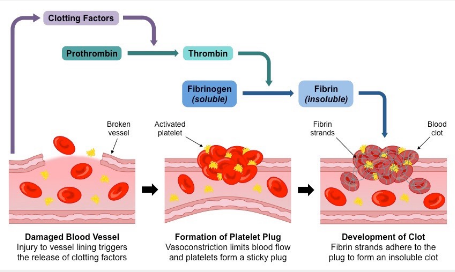
innate immunity
responds to broad categories for pathogens (ex. coughing, mucous, skin, stomach acid). does not change during life
phagocytes
type of white blood cell, part of innate immune system. digests and engulfs all foreign bodies indiscriminately. uses enzymes from lysosomes to digest
adaptive immunity
responds to specific pathogens and builds up memory of pathogens form the past, more effective protection (ex. white blood cells)
lymphocytes
type of white blood cell (about 25% of them) that identifies specific types of pathogens and creates a specific antibody , which is a protein that destroys pathogens.
they also occur in the lymphatic system. there are large numbers of them inside lymph nodes (swollen structures along lymph vessels, which drain excess fluid from the body)
they can detect the difference between body cells and foreign cells by differentiating between cells based on molecular composition, particularly antigens (molecules that stimulates the immune system) are located on the surface of the pathogen and then creates a specific antibody.
infected wounds attract large numbers of phagocytes, resulting in the formation of pus.
sometimes this system fails and lymphocytes interpret body cells as foreign cells, which leads to autoimmune disease like type 1 diabetes.
antibody production
happens over a few days, macrophages (type of phagocytic white blood cell ) engulf pathogens so antigens are displayed.
when this happens, Helper T-lymphocytes (T-cells) bind to antigen and are ‘activated’.
the activated T cells along with the antigens will bind to B lymphocytes (B-cells).
this binding will stimulate the B-cells to divide.
the daughter cells will mature into plasma B-cells (they develop an extensive endoplasmic reticulum with many ribosomes and a large golgi apparatus for rapid antibody production), and an army of plasma B-cells will secrete millions of antibodies into bloodstream and lymphatic system together.
memory plasma B-cells
some of the plasma B-cells don’t immediately produce antibodies, but they will stay inactive in the body for a while until it comes in contact with the same pathogen. a second time, the body will be able to battle the pathogen much faster. some remain for weeks, months, years or even a lifetime
HIV
human immunodeficiency virus, destroys CD4 cells, a type of white blood cell that stimulates other immune cells to fight infection.
The loss can lead to AIDS (acquired immunodeficiency syndrome),
the most advanced stage of infection.
HIV can be transmitted when bodily fluids are exchanged between people through penetrative intercourse (abrasions to the mucous membranes can cause minor bleeding), needle sharing, and/or pregnancy
antibiotics
fight bacteria in people and animals. they block the DNA replication of prokaryotes. it does not work on viruses. too much antibiotic use will eventually lead to bacteria becoming resistant to it. ex. penicillin
antibiotic resistance
some bacteria have evolved to be resistant.
antibiotics will kill some bacteria, the ones that are resistant will multiply so that there is now a high number of resistant bacteria. bacteria can also transfer genes to other bacteria, making more immune faster.
to avoid:
doctors should prescribe antibiotics only for serious bacterial infections for the minimum period
farmers should not use antibiotics in animal feeds as growth stimulants
hospital staff must maintain high standards of hygiene and new classes of antibiotic must be developed